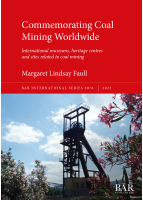Description
This book contains descriptions of 432 coal-mining museums, heritage centres, archives and memorials, and preserved colliery sites in 48 countries in Africa, America, Asia, Australia, Europe and New Zealand. This is not a history of coal mining, but rather a catalogue of how museums around the world have portrayed the history of coal mining, colliers and mining communities. This includes subjects such as the development and dissemination of new technology, features commonly found on the surface of mines, disasters, transport, women and children working underground, working conditions, strikes and trade unions, and slavery and forced labour, especially in wartime and by certain countries in particular. There is a detailed introduction, including discussion of the types of buildings used for museums and collections such as art and fossils, and a concordance of 18 items found commonly at the sites described, including those with a genuine or a simulated underground experience and opencast sites open to the public.
AUTHOR
Margaret Faull was director of the National Coal Mining Museum for England from 1986 until 2015 and is Honorary President of the Network of European Coal Mining Museums. In 2008 she was appointed OBE for services to industrial heritage. She has published widely in Anglo-Saxon, landscape and industrial archaeology.
REVIEWS
‘A delightful book to review. Fine and interesting examples of the multiplicity of heritage sites are reviewed, covering the diverse instances of the lived experience of many communities across the globe, both past and present.’ Kenneth E. Jackson, Journal of Australasian Mining History 20, October 2022
‘(T)his volume is far more than a list of locations but is an expert summary of the mining history and heritage of each country, bringing out areas of difference as well as commonality.’ Mark Dixon, Subterranea Britannica 60, August 2022
‘(A) book in which the author’s own voice sings through. Far more than a gazetteer, it is a richly illustrated guide to mining history and technology, mining communities, and memorials to those who have lost their lives to produce the material that powered the industrial revolution and transformed the world.’ Christopher Catling, Current Archaeology 39, October 2022
‘Researchers of industrial heritage will be interested in this volume because it provides the most comprehensive international directory of coal mining-related sites to date.’ Peer reviewer
‘In this exceptional book Margaret Faull charts the global history of coalmining through the material evidence of its remains, in museums, and preserved sites. Here is a unique record, not just in the comprehensiveness of its content but as reflection of the author’s outstanding experience, understanding and perception.’ Sir Neil Cossons
‘This international gazetteer is a major contribution to the global understanding of how industrial coal mining spread across the globe and how it is presented in the all the major national centres. There is no other published work that does this. This research has international appeal, especially in those countries where industrial heritage is actively promoted. Countries such as China, India, Japan, Europe, and north and south America have growing industrial heritage sectors where scholars would be appreciative of this work.’ Dr Michael Nevell, Ironbridge Gorge Museum Trust











